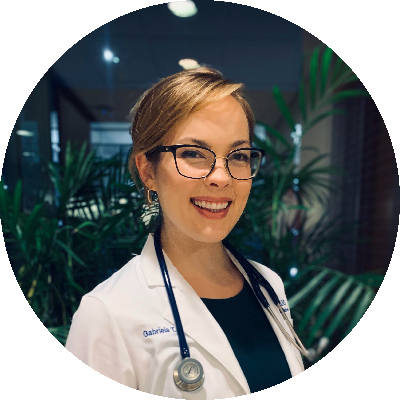
Gabriela T. Gomez
Cerebral small vessel disease is a major cause of stroke and a significant contributor to cognitive decline and dementia. My research with the SCAN (Stroke and Cognitive Impairment Analysis Using Neuroepidemiology) lab involved a data-driven analysis of the plasma proteome to facilitate a deeper understanding of peripheral biological changes that promote small vessel disease and to identify plasma biomarkers that can noninvasively identify individuals at risk for vascular cognitive impairment and dementia. From a panel of nearly 5,000 proteins, we identified 13 that were associated with neuroimaging characteristics of small vessel disease in a large, community-based cohort. Nine of these proteins replicated in one or more external cohort and two proteins remained associated with late-life small vessel disease when measured during midlife. These findings provide the field with select plasma biomarkers and possible mechanistic mediators that can inform the development of novel therapeutic approaches.
Questions & Answers
Why did you choose Johns Hopkins for your work?
I first moved to Baltimore for the Johns Hopkins premedical post- baccalaureate program. I chose Johns Hopkins because of the collegial environment and because it is a world-renowned center of excellence in aging research and geriatric clinical care. I stayed at Johns Hopkins for my medical and master’s degrees not only because of the world class clinical and research training but also due to the nurturing environment for trainees and the empathic mentorship and delivery of health care.
What does receiving this award mean to you personally and professionally? Do you have any connection with the particular award you received?
Receiving the Paul Ehrlich Award is both humbling and meaningful, as it marks the scientific, professional and personal growth I have experienced as a result of the outstanding, longitudinal mentorship of Dr. Keenan Walker and Dr.Rebecca Gottesman.
What contributed to your project’s success?
This project’s success was largely due to the brilliance of my mentors, Dr. Keenan Walker and Dr. Rebecca Gottesman, and their support of my independence and leadership as a student investigator. The collaborative environment within the SCAN lab — which brings together clinicians and scientists from the Johns Hopkins Department of Neurology, the National Institute on Aging and the National Institute of Neurological Disorders and Stroke — enhanced the innovation and impact of this work. Additionally, my fruitful partnerships with the Cardiovascular Health Study, the Baltimore Longitudinal Study of Aging and the Generation Scotland study throughout this project broadened the generalizability and scope of our work.
What thoughts do you have about Young Investigators’ Day itself, as a celebration of the roles student and fellows play in research at Johns Hopkins?
The Young Investigators’ Day typifies the culture ubiquitous at Johns Hopkins of nurturing learners and amplifying the work of trainees.
What has been your best/most memorable experience while at Johns Hopkins?
I have had so many memorable experiences throughout my time at Johns Hopkins. One particularly memorable experience was taking a small seminar course, Biological Basis of Aging, led by Joseph Margolick in the Johns Hopkins Bloomberg School of Public Health. Engaging with giants in the field of aging research — including Luigi Ferrucci, Linda Fried and Edward Lakatta, whom I have looked up to for years — on the mechanisms of aging, and even my own research, was very inspiring.
What are your plans over the next year or so?
During the upcoming year, I will be entering my fourth year of medical school and applying to residency.
Tell me something interesting about yourself that makes you unique. Do you have any special hobbies, interests or life experiences?
I am an avid powerlifter! Powerlifting requires dedication, patience and a focus on holistic health — all qualities that also strengthen my research and growth as a physician in training. Surrounding myself with strong women who are eager to take up space — in and outside of the gym — is very important to me.